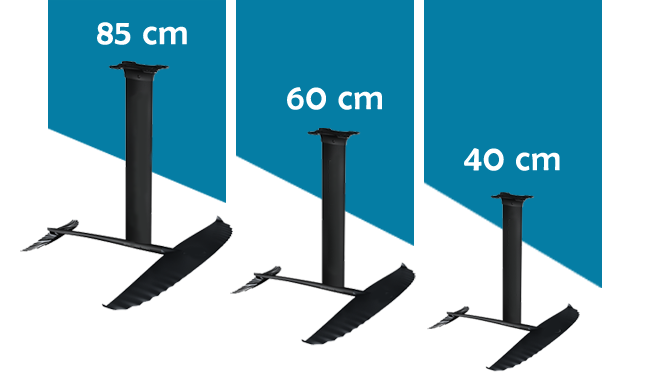Kitesurf Hydrofoil Lessons
Already mastered the art of kitesurfing and want to try it with a new twist? Ride with us, as we are here to fly with you! Kite N’ Surf provides one-of-a-kind kitesurf hydrofoil lessons in Zanzibar. We offer a variety of hydrofoil lessons matched with our expert Instructors. Our school is the best in equipping you with skills and techniques to make your kitesurfing experience awesome!
3 STAGES OF KITESURFING HYDROFOIL LESSON
Our hydrofoil lessons in Zanzibar are drafted to utilize the use of the coaching equipment provided by the Cabrinha Foiling Flight School.

STAGE 1
3 hours (1-hour lesson plus 2 hours of practice with 40 cm mast)
During this kitesurf hydrofoil in Zanzibar , the goal is to be able to help you gain the confidence to be able to handle the foil board. You would be able to keep the board as close to the surface while using the short mast.
STAGE 2
3 hours (1-hour lesson plus 2 hours of practice with 60 cm mast)
In this next lesson, we would teach you how to keep the kite steady at an angle of approximately 45 degrees. You do this while riding this board with a medium-size mast.
You would start to lift the board about 20-30 cm. You can experiment with how much power you can generate by gently pulling or releasing the bar.
STAGE 3
3 hours (1-hour lesson plus 2 hours of practice with 85 cm mast)
In this last lesson, we will allow you to maximize your hydrofoiling experience. You can now try to ride higher and faster than ever before using the 85 cm mast.
HYDROFOIL LESSONS REQUIREMENTS
Kitesurfing hydrofoil lessons are reserved for experienced kiters — those who are proficient at riding upwind, have good kite control, and have good coordination.
KITE N’ SURF PACKAGES OFFER
| HYDROFOIL BOARD RENTALS | RATE |
| 2 HOURS | 45 USD |
| HALF-DAY | 75 USD |

Most likely, you saw it on the internet or somewhere while you were on vacation. But, do you actually have an idea what it’s all about? Let’s find out… By definition, Kitesurfing is the sport or pastime of riding on a modified surfboard while holding on to a specially designed kite, using the wind for propulsion. Oftentimes, Kitesurfing is being compared to Kiteboarding, as many people use both terms interchangeably to refer to the same sport. One may think they are one and the same but there is, however, a slight technical difference between them. What’s the difference, you ask? The sport of kitesurfing is in fact a specific form of kiteboarding. Unique to this process is that it uses a directional board – a surfboard that was created for
It usually takes about 9 hours of hydrofoil lessons to get you started. Which covers all of the basic skills you will need to know to get up and ride. Riders progress at a different pace based on their kite surfing experience over the years and having experience with a directional board makes a big difference in the learning process.
With the kitesurf hydrofoil in Zanzibar, you’ll be hooked from the first ride! Don’t say we didn’t warn you.
HYDROFOIL LESSONS SECTIONS:
![]()
This is where you would be able to learn safety and how your foil behaves with a shorter mast. A 40cm mast will allow you to master basic foiling skills such as:
- The proper way to carry your foil
- Body dragging and swimming with it
- Get it in position to water start
- Get it under your feet so that you can move through the water
- KEY SKILLS
- Bend your knees.
- Move your weight from the back foot to the front foot.
- Release the bar (to avoid excessive power and kite backstalling)
- Speed is the key.
Body Drag First:
As a beginner, it shouldn’t take long to develop this skill. This step, however, is vital to get a sense of how the board will react when the foil is attached. Many kiters consider it an integral part of their training so they can be more confident when going out into deeper water.
Using your forearm and elbow as leverage, grab your front foot strap as you hold your hydrofoil board. And then, go ahead and position the foil in the water at about a 45-degree angle. Do this in case the water is deep enough.
Proper Starting Position:
Before you go ahead and attempt to start, you have to make sure that the foil is positioned at the surface of the water. You should be able to read the wind direction and feel where the kite is going. Using the kite’s pull to keep you aligned with the right direction is key.
Once you’re out of the water, your board should be pointed moderately upwind. This way, you’ll be able to get a slow start, which is essential so you won’t lose your balance. With a shorter mast, you’ll quickly discover these basic steps more effectively than if you were using a larger setup.
Footstraps:
When you start, straps help you get the board into position, while a loose fit will allow you to slip out of them when you crash.
Keep it level:
Getting your board level with the water should be the main objective at this point. Keep in mind that the foil will enhance whichever direction your board is angled. Beginning with your hips, make subtle changes in position. A slight change in posture can have a dramatic effect on the foil’s performance.
Look Out Below:
It is important not to kick the foil into the water. Although it may sound silly, some kiters forget that their foil is underwater as they maneuver it into position. Just in case you accidentally crash into the water, be aware that the hydrofoil board has a lot more speed and distance than a surfboard or twin tip. If you fall right in front of it, there is a good chance that it will chase you down. Try to avoid this scenario at all costs.
Stay Close:
Once you’re accustomed to the foil, you should try to keep your starting and ending points relatively equal. With the foil acting like a giant fin, staying upwind is easy. Beginners may find riding downwind more challenging than staying upwind. Until you become familiar with it, you should try to use your starting point as neutrally as possible, considering the conditions and geography of your location.
![]()
By the time you are proficient at cruising back and forth on the 40 cm mast, you should be able to advance to the 60 cm mast. With a 60 cm mast, getting your first extended foil ride is as easy as pie. After a while, you will begin to remain on the water longer between foilings.
KEY SKILLS
- Balancing your weight with Kite steady at 45 degrees
- Lifting the board (engaging the foil) while at a steady speed.
- Ride Downwind
The shorter mast will make handling much easier. Once you get used to the differences in balance and kite control that foiling requires, you’ll be amazed at how quickly you progress.
![]()
As soon as you are capable of maneuvering back and forth on the 60cm mast and can sail short distances out of the water, you will be able to learn the following:
Kick Free Crash:
You will occasionally crash. You can’t avoid that. But if you do, make sure you kick-free from your board and crash away as far as you can. Keep your foot straps loose to avoid colliding with your board. Taking this step will help prevent any injuries from occurring.
Control speed and lift:
During this phase, you will learn how to control the pace as you build speed and gain comfort. A sudden change of speed can mean the difference between a soft touchdown and a big crash.
In order to pull this off, you must keep control of the kite, edge properly, and keep pressure on the front foot. You can ease power from your kite by slowly bringing it higher in the window. By applying strong pressure to the front foot, you can control the lift created by speed.
When you want to return to neutral, you can either edge hard upwind (if you’re ready for that) or, let off the foil and ride out the speed. Once you do this, you will be able to return to a comfortable pace.
Now that you’ve learned the basics of how to operate a kitesurf hydrofoil, it’s time to hit the water! Let’s go ahead:
- If you move the mast forward, the board will be pulled out of the water very quickly. So, you have to ensure that you set up the foil of your kiteboard in the most backward position on the box. By learning this method, you will develop muscle memory, which allows you to learn faster.
- Make sure your foot straps are loose so that when you wipe out, you can easily eject completely from the board.
- The foil should always be carried like a surfboard, as close as possible to the mast, with the foil on your right side facing upwind.
- As you walk to deep water, you try to keep the foil from hitting the ocean floor.
- With a leeward/backhand, hold onto the front foot strap when body dragging.
- One of the skills that you need to learn and know by heart is how to water start. And if you’re in deep water, this method is really helpful. With your backhand, grab the front foot strap, pulling towards your body while pushing your elbow down and pointing the foil in the water’s direction. By doing this, the foil will be in a prime starting position.
- Upon getting on the rail, you have to quickly do the water start. This will give you a whole new sensation, even if you move the foil backwards.”
- In comparison to traditional kiteboarding, foil kiteboarding requires more foot pressure in the front, so make it a habit to keep your foot firmly on the gas pedal.
With practice, your instinct will automatically adjust your weight to get the foil gliding smoothly over the water. Then, if you’re sure you’re ready to switch to advanced mode with your foil, slide the wing forward by one inch. By doing this, you will experience more lift in the water.
